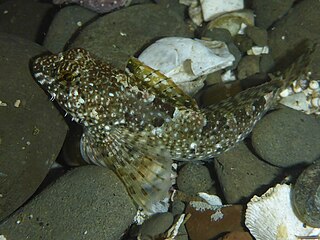
The spoonhead sculpin is a species of freshwater ray-finned fish belonging to the family Cottidae, the typical sculpins. This species is widespread in northeastern North America.

The Pacific staghorn sculpin is a species of marine ray-finned fish belonging to the family Cottidae, the typical sculpins. This species is found in the eastern Pacific Ocean. It is the only species in the monospecific genus Lepidocottus.

The Norway bullhead is a species of marine ray-finned fish belonging to the family Cottidae, the typical sculpins. This species is found in the northeastern Atlantic Ocean.

The roughback sculpin is a species of marine ray-finned fish belonging to the family Cottidae, the typical sculpins. This species is found in the eastern Pacific Ocean. The roughback sculpin is the only known member of the genus Chitonotus.

Enophrys is a genus of marine ray-finned fishes belonging to the family Cottidae, the typical sculpins. These fishes are found in the northern and eastern Pacific Ocean.
The lavender sculpin is a species of marine ray-finned fish belonging to the family Cottidae, the typical sculpins. It is found in the eastern Pacific Ocean.
The spineless sculpin is a species of marine ray-finned fish belonging to the family Cottidae, the typical sculpins. This species is found in the Pacific Ocean where it is endemic to the waters around the Aleutian Islands, Alaska.

Myoxocephalus jaok, the plain sculpin, is a species of marine ray-finned fish belonging to the family Cottidae, the typical sculpins. This species is found in the northern Pacific Ocean and adjacent Arctic Ocean.

Myoxocephalus scorpioides, the Arctic sculpin or northern sculpin, is a species of marine ray-finned fish belonging to the family Cottidae, the typical sculpins. This fish is found in the Arctic Ocean.

Artedius corallinus, the coralline sculpin, is a species of marine ray-finned fish belonging to the family Cottidae, the typical sculpins. It is found in the eastern North Pacific along the coasts of the western United States and Baja California.

The woolly sculpin is a species of ray-finned marine fish belonging to the family Cottidae, or the typical sculpins. It is found in the eastern Pacific Ocean, where it occurs along the coastline of California south to Baja California.

The rosy sculpin is a species of marine ray-finned fish belonging to the family Cottidae, the typical sculpins. It inhabits the coastal northeastern Pacific Ocean, ranging from California (US) to Baja California.

The bald sculpin is a species of marine ray-finned fish belonging to the family Cottidae, the typical sculpins. It is found in the eastern Pacific Ocean.

Artediellus atlanticus, the Atlantic hookear sculpin or hookhorn sculpin, is a species of marine ray-finned fish belonging to the family Cottidae. This species is found along the coasts of Northern Atlantic Ocean.

Icelinus borealis, or the northern sculpin or comb sculpin, is a species of fish in the family Cottidae. It can be found in the northeastern Pacific Ocean along the western coast of North America.

The hamecon is a species of marine ray-finned fish belonging to the family Cottidae. This species is found along the coasts of northeastern Atlantic Ocean and in the Arctic Ocean.

Enophrys diceraus, the antlered sculpin, is a species of marine ray-finned fish belonging to the family Cottidae, the typical sculpins. This species occurs in the northern Pacific Ocean.

Gymnocanthus pistilliger, the threaded sculpin, is a species of marine ray-finned fish belonging to the family Cottidae, the typical sculpins. This species occurs in the northern Pacific Ocean.

The Arctic staghorn sculpin is a species of marine ray-finned fish belonging to the family Cottidae, the typical sculpins. This sculpin is found in the Arctic Ocean and the northern Atlantic Ocean.

Clinocottus embryum, the calico sculpin or mossy sculpin, is a species of marine ray-finned fish belonging to the family Cottidae, the typical sculpins. It is found in the eastern Pacific Ocean.



















